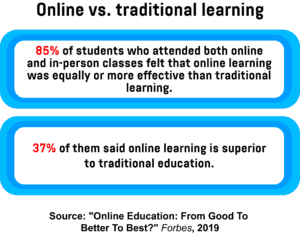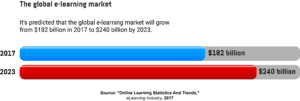- Technology positively impacts all age groups
- Online learning is gaining popularity
- A free education for everyone
- More people receive virtual education
- Parents and schools turn to tech to protect children
- Academic records will be stored on blockchain
- The changing face of modern education
Technology has changed our everyday lives in all aspects, and this disruption is happening in the education sector as well. Learning is more accessible and personalised, and students can acquire knowledge in a more enjoyable way, both inside and outside the classroom.
Education technologies such as artificial intelligence (AI), robotics, blockchain, and virtual reality (VR) aren’t just transforming the field for students. Emerging tech also impacts the way teachers deliver their instruction. And while pessimists continue to warn that new advances will only destroy teachers’ jobs and make them obsolete, such a scenario is still far from reality. Instead, educational institutions should take a more positive approach to technology adoption and understand the benefits that technology provides. Schools of tomorrow are likely to be dominated by tech, with the human touch still playing an important role.
Technology positively impacts all age groups
The education industry is becoming more complex, and students face many barriers. This is especially the case in higher education, where students aren’t well prepared to “navigate college as a system”, so, as a result, they risk failing. For instance, students who have a job can find it hard to balance school and work, while some can easily become frustrated with the lack of affordable places to live off-campus. And even when schools have a solution to these issues, students are often embarrassed to seek help. The Wayne State University in Michigan realised the importance of this problem and decided to address it by developing an AI chatbot solution called W the Warrior.
Through text messages, the chatbot will answer prospective students’ questions and help them with the application and enrollment process. The university started experimenting with the chatbot in 2018, and according to Dawn Medley, Wayne State’s associate vice president for enrollment management, the solution helped improve student enrollment by 14.6 per cent.
But technology isn’t just a useful tool for younger students. For instance, a study conducted by the Native English Institute (NEI) and the AI company Blue Canoe Learning showed that edtech can also help adult learners. During a three-month-long study, Russian and Japanese participants used the Blue Canoe language learning app to improve their fluency in English. The app is designed to stimulate “the visual, music, and movement parts of the brain to better perceive and produce the sounds of a new language”. The experiment revealed that learners’ pronunciation score, which was analysed with machine learning, increased by 31 points.
Online learning is gaining popularity
The days of sitting in a classroom and listening to a teacher giving a dry, boring lecture are slowly becoming a thing of the past. Under the influence of emerging technologies, education is transforming into a more fun and enjoyable experience. What’s more, thanks to the internet, online learning has become very popular and widely available. It brings many benefits, as it ‘democratises’ education, allowing students to learn anytime, anywhere. Additionally, online learning allows students to learn at their own pace. And the e-learning market is growing, with its value estimated at nearly $182 billion in 2017 and predicted to grow to $240 billion by 2023.
It’s not surprising that online learning has seen a boom in popularity in recent years, as it offers many benefits. For instance, since they’re always available online, these courses allow learners to choose when they want to have class, and also enable them to revisit certain topics later on to refresh their knowledge. Also, online learning platforms are increasingly introducing elements of gamification into their courses, making learning interactive, fun, and engaging.

But perhaps the most important feature of online education is choice. Students can choose an area of study that might not be available in their city or country. Furthermore, online education is much more affordable than traditional schools, and even free in some cases, which allows students from any background to get a quality education. Web-based learning is also suitable for learners of all ages, whether it’s a young adult looking to change careers, or an elderly person who wants to learn new skills.
According to a study conducted by Learning House in 2018, 85 per cent of students who attended both online and in-person classes felt that online learning was equally or more effective than traditional classrooms. What’s more, 37 per cent of them said that online courses were superior to traditional education.
And based on the findings of Best Colleges’ “2019 Online Education Trends Report”, 89 per cent of students who have completed an online program would recommend it to others.
A free education for everyone
One of the pioneers in online learning is the Khan Academy, which aims to offer “a free, world-class education for anyone, anywhere”. This non-profit offers various online educational materials in areas such as maths, science, computing, and arts. It also offers students the option to practice for standardised tests such as the SATs to prepare for their university education. And to make its learning materials even more engaging, the Khan Academy partnered with institutions such as The Museum of Modern Art, The California Academy of Sciences, NASA, and MIT.
More people receive virtual education
Focusing on virtual education has proved to be a success for the Union School Corporation, a public school district located in Indiana, the US. Not that long ago, this school district had only 256 students in K-12 grades and was “on the verge of closure”. But after the district started an online program called Indiana Digital Learning School (INDLS), its enrolment rates increased significantly. Today, besides two traditional schools, the Union School Corporation also has three virtual schools, which employ 100 certified teachers. And to make sure that students are actually learning, this virtual school provides live full-day classes that take attendance, just like in a traditional classroom.
However, with more people receiving virtual education, some issues may arise. The Indiana State Senator Jeff Raatz explains that many students who use virtual education have very low high school credits. Raatz adds that virtual schools’ officials will need to pay more attention to this issue.
To improve the quality of virtual education, Indiana lawmakers passed a new law that requires students who enroll into virtual classes to undergo an “onboarding process and orientation”. The new rule applies to students who will be enrolling into virtual schools in 2020. Also, it implies that pupils who are absent from school without an appropriate excuse will be removed from the virtual program. These students, also called ‘habitual truants’, have been a major issue for Indiana’s virtual programs, because schools that register these students receive funding for their education.
Parents and schools turn to tech to protect children
Technology is also shaping the schools of tomorrow by improving security. Incidents such as mass shootings, child abductions, and robberies happen almost on a daily basis, and it’s important that schools see student safety as their top priority. With so many innovative solutions on the market, schools and parents can track students’ location throughout the day to make sure they’re kept safe from potential threats. Although advances in location-tracking technology bring privacy concerns, more tech companies are incorporating location-based services into their products. This is already having an impact on the global school and campus security market, which is expected to reach $2.54 billion by the end of 2023.
Among the countries that are fully embracing location-based technology is China. To protect its students, China has given them location-tracking smartwatches, called Safe Campus Smartwatches. MIT Technology Review reports that China’s government has equipped 17,000 students from 60 elementary schools located in the city of Guangzhou with this wearable technology. The smartwatches are equipped with a positioning chip designed to determine the user’s location within 10 metres. Once connected with parents’ smartphones, this innovation will allow them to monitor their child’s location and receive emergency alerts. The wearable will also notify parents if their child gets too close to a river or lake. Participation in this project is completely voluntary, and China’s authorities claim all data will be stored in a database controlled by the police department and the Ministry of Industry and Information Technology.
While some schools are relying on technology to track students’ location, the Williamson County School (WCS) District in Tennessee, the US, is using an AI program to keep track of students’ communication online. Sometimes during classes, students will use the district’s server My Place to communicate with their peers. They also rely on My Place to communicate with their teachers about class assignments. Once they’re logged into the server, a program called Gaggle will monitor what they type and detect high-risk words and phrases. If the system detects words that indicate a potential threat, it will notify school officials. This will allow the school to intervene and keep students safe.
Academic records will be stored on blockchain
And cutting-edge tech solutions will even change the way universities store academic records. Most institutions across different levels of education rely on paper-based methods to store valuable information such as students’ grades, diplomas, and certificates. Such outdated documents waste time, money, and space, and can be easily misplaced or misused. By employing blockchain technology, however, schools could cut costs, improve efficiency, and ensure transparency.
Although blockchain’s use in education is still in the early days, some educational institutions are already experimenting with this tech. One of those institutions is the Southern Alberta Institute of Technology (SAIT) in Canada. Thanks to a partnership with the blockchain-powered learning platform ODEM, SAIT’s graduates were the first in Canada to receive digital certificates stored on a blockchain system.
The partnership with ODEM started as a pilot project in 2018, when 25 post-secondary graduates received their academic records stored on blockchain. Now, SAIT has deployed a solution to store digital diplomas and certificates for over 4,800 of its 2019 graduates. ODEM’s technology is tamper-proof, and it gives students more control over their records. Due to blockchain’s convenience, students are able to share their documents with future employers. But SAIT hasn’t transitioned completely to blockchain, so along with digital records, graduates will also receive a traditional paper-based diploma.
The changing face of modern education
Like every other industry today, education is experiencing a major shift. New technologies are changing the way students acquire knowledge, as well as how they interact with their teachers and other students. While digital disruption might change the status quo, it won’t make teachers obsolete, and the quality of content will remain a major priority. Also, face-to-face interaction will continue to have a strong presence in education, and combined with innovative edtech solutions, it can do wonders for both students and teachers.
Share via:



